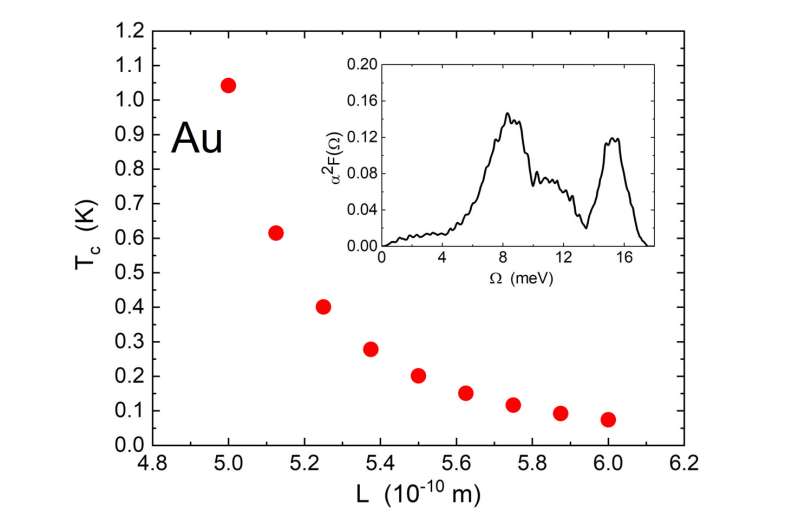

Superconductivity is the phenomenon by which, at sufficiently low temperatures, electric current can flow in a metal with no resistance. While certain metals are excellent superconductors, other metals cannot superconduct at all.
Understanding what makes a metal superconducting is still an open question in fundamental condensed matter physics. Also, superconductivity in simple elemental solids is of great importance for technological applications—consider that elemental aluminum is used ubiquitously for superconducting Josephson junctions employed in quantum computing (e.g., for qubit implementation).
For these reasons, an important line of research in recent decades has been devoted to finding new elements that could become superconducting under certain conditions.
In this paper, published in Physical Review Materials, we proposed a completely new twist to the search for new elements that can become superconductors.
Over the past few years, I have worked on a new approach to quantitatively determine how the thickness of a thin film influences the electronic properties of a very thin metal slab. The key principle is that only electron waves will be allowed to populate the thin slab which has a wavelength that does not exceed the size of a sample along a certain propagating direction.
Clearly, along the direction orthogonal to the slab surface, the maximum allowed wavelength will be of the order of the film thickness, whereas in the perpendicular plane, the electron wave will be able to propagate with any wavelength.
A first implementation of this quantum confinement model with my former student Riccardo Travaglino yielded encouraging results for ultra-thin films of lead in comparison with experimental data in the literature.
However, the calculation was based on the Bardeen-Cooper-Schrieffer theory of superconductivity, which falls short of accuracy when the coupling between electrons and phonons in the lattice is strong and does not account in a realistic way for the phonon spectrum.
I then started collaborating with colleague Giovanni Ummarino in Turin, who is an expert of the more refined and realistic Eliashberg theory of superconductivity, which can handle all the above mentioned points in an accurate and fully quantitative way, without any adjustable parameter.
Using the most refined version of the Eliashberg theory of superconductivity combined with ab-initio simulations and with a recent quantum confinement model for quasi-2D materials, we have now predicted that noble metals become superconducting when cast into ultra-thin films of thickness lower than 1 nm.
The theory is fully quantitative and free of adjustable parameters. The most striking prediction is that ultra-thin gold (Au) films of about half a nanometer thickness become superconducting with a critical superconducting temperature equal to 1.1 Kelvin. This is basically the same critical temperature of aluminum (Al), which is the most used material for Josephson junctions implemented in qubits for quantum computer.
This prediction can open up new ways to realize ultra-thin superconducting films of noble metals, which will combine unique electronic and mechanical properties with experimentally accessible superconductivity.
This story is part of Science X Dialog, where researchers can report findings from their published research articles. Visit this page for information about Science X Dialog and how to participate.
More information:
Giovanni Alberto Ummarino et al, Can the noble metals (Au, Ag, and Cu) be superconductors?, Physical Review Materials (2024). DOI: 10.1103/PhysRevMaterials.8.L101801. On arXiv: DOI: 10.48550/arxiv.2406.16621
Bio: Alessio Zaccone received his Ph.D. from the Department of Chemistry of ETH Zurich in 2010. From 2010 till 2014 he was an Oppenheimer Research Fellow at the Cavendish Laboratory, University of Cambridge.
After being on the faculty of Technical University Munich (2014–2015) and of University of Cambridge (2015–2018), he is a full professor and chair of theoretical physics in the Department of Physics at the University of Milano since 2022. Awards include the ETH Silver Medal, the 2020 Gauss Professorship of the Göttingen Academy of Sciences, the Fellowship of Queens’ College Cambridge, and an ERC Consolidator grant (“Multimech”).
Research contributions include the exact solution to the jamming transition problem (Zaccone & Scossa-Romano PRB 2011), the analytical solution to the random close packing problem in 2d and 3d (Zaccone PRL 2022), the theory of thermally-activated reaction rate processes in shear flows (Zaccone et al. PRE 2009), the theory of crystal nucleation under shear flow (Mura & Zaccone PRE 2016), the theoretical prediction of boson-like peaks in the vibrational spectra of crystals (Milkus & Zaccone PRB 2016; Baggioli & Zaccone PRL 2019), the theory of the glass transition in polymers (Zaccone & Terentjev PRL 2013), the discovery of well-defined topological defects in glasses (Baggioli, Kriuchevskyi, Sirk, Zaccone PRL 2021), the theoretical prediction of non-monotonic superconductivity enhancement effects due to phonon damping (Setty, Baggioli, Zaccone PRB 2020).
Research interests range from the statistical physics of disordered systems (random packings, jamming, glasses and the glass transition, colloids, nonequilibrium thermodynamics) to solid-state physics and superconductivity. In 2023 he contributed a monograph “Theory of Disordered Solids” (Springer, Cham, 2023).
Journal information:
arXiv
Citation:
Can the noble metals become superconductors? (2024, November 7)
retrieved 7 November 2024
from https://phys.org/news/2024-11-noble-metals-superconductors.html
This document is subject to copyright. Apart from any fair dealing for the purpose of private study or research, no
part may be reproduced without the written permission. The content is provided for information purposes only.